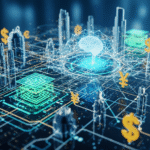In the modern world, we are told that “content is king.” But if content is king, then attention is the new currency. In an age of information overload, where our phones buzz with notifications and our screens are awash with an endless stream of digital media, our focus has become a scarce and highly valuable resource. This shift has given rise to a new economic paradigm: the attention economy.
But what exactly is the attention economy, and who are the real beneficiaries of this new, invisible marketplace? The answer is more complex—and more troubling—than it might seem. We, the users, are often led to believe that we are the consumers of free services and entertaining content. In reality, we are the product, and our attention is the commodity being bought and sold on a massive, global scale.
This article will pull back the curtain on this hidden economy, exploring its history, its mechanics, and the profound impact it has on our lives, our society, and our wallets. We will delve into the intricate web of platforms, creators, and data brokers that profit from our focus, and we will reveal the true cost of this digital transaction.
Understanding the Attention Economy: A Primer
The concept of the attention economy isn’t new. It was first articulated by Nobel laureate Herbert A. Simon in the 1970s, who famously stated, “a wealth of information creates a poverty of attention.” Simon’s foresight has been proven spectacularly correct in the digital age. With the advent of the internet and the proliferation of mobile devices, we have a literal wealth of information at our fingertips. But our capacity to process it remains finite.
This scarcity of attention is what makes it so valuable. For every brand, media company, or content creator, the primary goal is not just to produce information, but to capture and hold our limited attention for as long as possible. The more time we spend on a platform, the more data that platform can collect about us, and the more opportunities it has to show us advertisements.
This is the fundamental business model of almost every major social media platform, search engine, and “free” service we use today. We don’t pay with money; we pay with our time, our clicks, and our personal data.
The Rise of the Attention Merchants
While the attention economy has reached its zenith in the digital age, its roots can be traced back to the 19th-century newspaper industry. Publishers like Benjamin Day realized that they could sell newspapers for less than the cost of production and make up the difference by selling space to advertisers. The readers, in this model, were not the customers—they were the product being sold to the true customers: the advertisers. This business model, perfected by commercial radio and television, is now the bedrock of the digital world.
Today, the “attention merchants” have simply evolved. They are the tech giants with their sophisticated algorithms and data-driven platforms. They are the streaming services that autoplay the next episode to keep you glued to the screen. They are the mobile games with push notifications and daily rewards designed to pull you back into the app.
The Key Players: A Detailed Comparison
To truly understand who profits, we need to look at the different layers of this hidden economy. It’s not just a one-way street from user to platform. There is a complex ecosystem of businesses and individuals who benefit.
| Player | How They Profit | Key Strategies |
| Social Media Giants (e.g., Meta, TikTok) | They are the primary brokers of attention. Their core business is selling targeted advertising. They use complex algorithms to keep users engaged for as long as possible, collecting vast amounts of data to create highly specific user profiles. This data allows them to sell ad space to brands who want to reach a very particular audience. | Infinite scroll, push notifications, highly personalized “For You” feeds, gamified interactions (likes, shares, comments). |
| Content Creators & Influencers | They profit by becoming mini-attention merchants themselves. Once they have a loyal following, they can monetize their audience’s attention through a variety of methods: brand deals, sponsored posts, affiliate marketing, and direct sales of their own products or services. Their success is directly tied to their ability to capture and hold attention. | Viral content, authenticity, direct engagement with followers, leveraging multiple platforms. |
| Data Brokers | These are the most invisible and arguably the most insidious players. They are companies that specialize in collecting, aggregating, and selling personal data. This data is often scraped from public records, social media, and third-party apps, then bundled into comprehensive user profiles that are sold to marketers, financial institutions, and even political campaigns. They profit from our attention without us even knowing they exist. | Scraping data from multiple sources, creating detailed consumer profiles, selling data bundles to a wide range of clients. |
| Digital Marketing Agencies | These agencies are the architects of the attention economy. They work with brands to create the campaigns, content, and strategies that are designed to capture our attention. They profit by helping their clients navigate the complex landscape of digital advertising and by optimizing their campaigns for maximum engagement. | A/B testing, search engine optimization (SEO), performance marketing, influencer outreach, behavioral targeting. |
Export to Sheets
This comparison shows that the profit-sharing model is not limited to the tech giants. It is a multi-layered system where each player, from the biggest corporation to the individual influencer, finds a way to extract value from our attention.
The Hidden Mechanisms: How They Capture Your Attention
The tools used to capture attention are not accidental. They are the result of deliberate psychological engineering and a deep understanding of human behavior.
1. The Power of Personalization
Platforms use sophisticated algorithms to create a personalized “feed” of content designed to be highly engaging for you, specifically. Every like, share, click, and even the time you spend hovering over an image is a data point. This data is used to build a model of your interests, beliefs, and emotional triggers. The algorithm then feeds you more of what you’re likely to engage with, creating a compelling, and often addictive, feedback loop.
2. The Dopamine Loop
Social media and other attention-driven platforms are engineered to trigger the brain’s reward system. The anticipation of a new notification, a “like,” or a comment releases a hit of dopamine, the same neurotransmitter associated with pleasure and addiction. This creates a “dopamine loop” that encourages compulsive checking and engagement.
3. Infinite Scroll and Autoplay
These simple design features are powerful tools for maximizing screen time. Infinite scroll eliminates the need for a deliberate action (like clicking a “next page” button) and creates a continuous stream of content. Autoplay on platforms like YouTube and Netflix ensures that as soon as one video ends, the next one begins, minimizing the chance for you to disengage.
4. Fear of Missing Out (FOMO)
The constant stream of content, from friends’ perfectly curated lives to breaking news alerts, creates a sense of urgency and social pressure. The fear of being out of the loop or missing an important update keeps us tethered to our devices, constantly checking and refreshing our feeds.
The Pros and Cons of the Attention Economy
Like any major economic shift, the attention economy is not without its benefits, but its drawbacks are far more significant and far-reaching.
Pros:
- Democratization of Information: The attention economy has made information, news, and entertainment more accessible than ever before. You don’t need to pay for a subscription to watch a viral video or read a breaking news story.
- Avenues for Creative Expression: The creator economy, a direct byproduct of the attention economy, has enabled millions of people to turn their hobbies and passions into a career. From YouTubers to podcasters, creators can build an audience and earn a living without traditional gatekeepers.
- Connecting People: Social media platforms have made it easier to connect with friends, family, and communities across geographical boundaries.
Cons:
- Impact on Mental Health: The constant need to be “on,” the pressure to create a perfect online persona, and the exposure to curated, often unrealistic, content can lead to anxiety, depression, and low self-esteem. The addictive nature of these platforms contributes to a fragmented sense of self and an inability to focus.
- Erosion of Privacy: Our attention is inseparable from our data. As platforms collect more and more information about our habits, beliefs, and relationships, our privacy is increasingly compromised. This data is then used not only for advertising but also for political manipulation and other opaque purposes.
- The Rise of Misinformation and Polarization: Algorithms are designed to show us what we are likely to engage with, which often means content that provokes a strong emotional reaction. This can lead to the creation of “echo chambers” and “filter bubbles” where we are only exposed to content that confirms our existing beliefs, making us more susceptible to misinformation and more polarized from those who hold different views.
- Loss of Critical Thinking: With the constant barrage of short-form, attention-grabbing content, our ability to engage in deep, focused work and critical thinking is diminishing. We are trained to skim and swipe rather than to read and reflect.
Who Should Be Wary of the Attention Economy?
While everyone is a participant in this new economy, certain individuals and groups are particularly susceptible to its negative effects.
- Young People and Adolescents: This demographic is especially vulnerable to the mental health impacts of social media, including body image issues, cyberbullying, and addiction. Their developing brains are highly susceptible to the dopamine loops and social pressures of these platforms.
- Small Businesses and Brands: Without the massive advertising budgets of corporations, small businesses can find it incredibly difficult to compete for attention. They are forced to engage in a “pay-to-play” system where visibility is contingent on advertising spend.
- Anyone Concerned with Privacy: If you value your personal data and want to limit the information that corporations and data brokers collect about you, you must be extremely mindful of the platforms you use and the information you share.
- Independent Journalists and Creators: While the attention economy has created new opportunities, it has also created a system where creators are at the mercy of platform algorithms. A simple change to an algorithm can decimate a creator’s reach and livelihood overnight.
FAQs: Unpacking the Hidden Economy of Attention
What is the difference between the attention economy and the creator economy?
The creator economy is a part of the attention economy. The attention economy is the broader system where attention is the commodity. The creator economy is the specific segment of this system where individual content creators are the producers, and they earn a living by monetizing the attention they generate.
How do data brokers get my information?
Data brokers collect information from a wide variety of sources, both online and offline. This includes public records (such as property records and court filings), social media activity, browsing history (cookies), app usage, and even loyalty card data. They then combine this information to build a comprehensive profile of you, which they sell to third parties.
Can I opt out of the attention economy?
While it is nearly impossible to completely opt out of the attention economy in a fully digitized world, you can take steps to reclaim your attention. This includes auditing your screen time, using apps that block notifications, implementing “digital detoxes,” and being more intentional about what content you consume and what platforms you engage with.
Is advertising the only way platforms profit from my attention?
No, but it is the primary way. Platforms also profit by selling premium subscriptions (e.g., ad-free versions), facilitating e-commerce (e.g., in-app purchases), and using user data to develop new products or services. However, the vast majority of revenue for platforms like Meta and Google comes from advertising.
How can I be a more mindful consumer of attention?
Being a mindful consumer of attention involves a few key practices:
- Set boundaries: Schedule specific times for checking social media and emails.
- Curate your feed: Unfollow accounts that make you feel bad about yourself and seek out content that is informative and genuinely enriching.
- Practice single-tasking: Resist the urge to constantly switch between tasks and dedicate your full attention to one thing at a time.
- Embrace boredom: Allow yourself to be bored. This is when your mind has the space to wander and be creative.
Conclusion: The Final Verdict on the Attention Economy
The hidden economy of attention is a powerful, pervasive force that has fundamentally reshaped our world. On the surface, it offers an abundance of free services and endless entertainment. But beneath the surface, a massive, data-driven machine is at work, commodifying our most precious and finite resource: our attention.
The real profits flow not only to the tech giants who act as attention brokers but also to the network of data brokers, advertisers, and creators who have mastered the art of capturing our focus. As we have seen, the cost is borne by us, the users, in the form of compromised privacy, diminished mental health, and a fractured sense of reality.
A Call to Action for the User
We are not powerless in this system. The solution is not to demonize technology but to become more conscious and intentional users of it. We must shift from being passive consumers to active participants who understand the rules of the game.
The final verdict is a call for a new form of digital literacy. We must learn to recognize the subtle cues and psychological triggers that are designed to exploit our attention. We must demand greater transparency from the platforms we use and advocate for regulations that protect our data and our well-being.







Leave a Reply